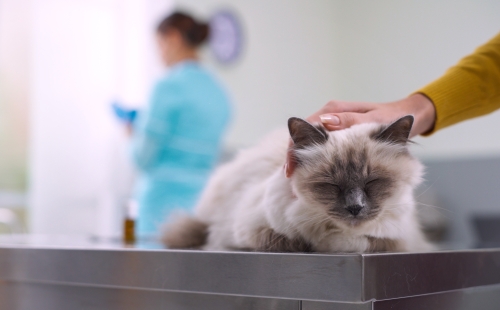5 Ways to Improve Efficiency and Reduce Veterinary Client Wait Times

Nobody likes to wait, especially loving pet owners fiercely worried about their furry pals. Long wait times frustrate pet owners and veterinary teams, creating tension on both sides of the exam table.
Whether a pet visits for vaccines, diagnostics, or preventive care, reducing their wait time can make for a smoother appointment and better client experience. Here are five practical ways to reduce wait times and boost efficiency in your veterinary practice.
1. Have anxious pets wait in the car
The waiting area can be stressful for many pets (and pet owners), especially with limited space. Let anxious pet families wait in the car until an exam room is ready. Real-time notifications sent through cloud-based practice management software allow pet parents to check in remotely and be notified when it’s their turn.
Reducing noise and chaos in the waiting room makes it easier for the reception team to focus on the tasks at hand: running the day’s schedule and promptly getting pets in and out. Plus, clients who wait in the comfort of their vehicle may feel more relaxed and have more tolerance for a short delay.
2. Streamline check-in
A lengthy check-in process creates instant bottlenecks that hamper efficiency. Send clients' paperwork in advance, collecting e-signatures on necessary forms, or asking clients to review and edit their information within a mobile app. Digitizing check-in frees up your front desk staff to handle the urgent, in-person matters that inevitably arise during a day’s work, helping to prevent slowdowns.
3. Implement automation
Pet parents are busy and sometimes arrive late to their pet’s veterinary care appointments. Automated appointment reminders can reduce schedule hiccups, such as no-shows and late arrivals, which can throw off the entire day’s efficiency. You can also add messaging to your reminder emails and texts informing clients of your late arrival policy so they know what to expect if they can’t get there on time.
4. Adjust staff schedules
A mismatch between staffing and appointment scheduling can cause back-ups and reduced efficiency. If your veterinary clinic gets slammed during certain parts of the day, it’s time to re-evaluate the team schedule.
Determine when you have the most team members available, and schedule the bulk of the day’s appointments and tasks during those times. Also, ensure you provide sufficient time for employees to decompress during breaks.
5. Train team members in triage
Not all appointments are created equal. Train your front-line team members in triage and establish protocols for handling urgent and emergent cases. Written flowcharts or protocols can help your team decide which pets should skip the line and which unscheduled patients can wait until scheduled clients have been seen. Clear communication is key to efficiency—use your software’s internal messaging systems, a third-party communication app, or a digital whiteboard to keep everyone on the same page.
Reducing the impact of long wait times
Clients are accustomed to long waits when they see human medical providers, so it may not be the actual wait time that upsets them. According to this study of ER wait times, patient satisfaction had more to do with perceived fairness, quality of communication, and comfort in the waiting area than with how long they waited.
Veterinary clinic team members can apply this by setting clear expectations for clients before the visit and when they arrive. Tell pet owners if the veterinarian is behind schedule and, when reasonable, tell them why. Did an emergency come in? Did surgery run long? Pet owners want to know that their pet will get the team’s full attention should something unforeseen happen to them, so they’re usually understanding when it happens to someone else. Receptionists and the front desk team should check in frequently with waiting clients and offer updates whenever possible.
Wait time reduction requires veterinary practice leaders to evaluate current protocols, identify bottlenecks, embrace technology, and train team members in client communication. A cloud-based PIMS that streamlines reminders, check-ins, check-outs, and schedule management can improve efficiency and allow your team to focus on client satisfaction and patient care.



